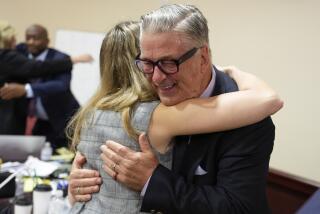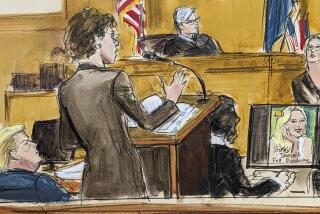New Simpson Case Evidence Delays Opening Remarks : Courts: Prosecution claims defense withheld information to sabotage government’s case. Fuhrman is accused of not revealing interview with Simpson neighbor.
A furious last-minute debate on evidence-sharing Monday postponed opening statements in the murder trial of O.J. Simpson, as prosecutors accused their counterparts of withholding evidence in order to sabotage the government case.
Superior Court Judge Lance A. Ito denied a prosecution request for a one-week postponement, but arguments over the new defense material occupied the entire morning in court, pushing back the scheduled start of opening statements and forcing Ito to reschedule them for this morning. Simpson has pleaded not guilty to the June 12 murders of his ex-wife Nicole Brown Simpson and her friend Ronald Lyle Goldman.
Ito ruled that defense attorneys had not promptly revealed names and other information about a host of witnesses and ordered lead Simpson trial lawyer Johnnie L. Cochran Jr. to avoid references to two dozen possible witnesses in his opening statement. But, despite prosecution objections, Cochran may refer to another 10--including Dr. Lenore Walker, a nationally recognized expert on domestic abuse who is working with the defense team.
As the two sides wrangled Monday, each revealed a few surprises:
* Defense lawyers filed a motion stating that LAPD Detective Mark Fuhrman, an officer who says he found key evidence in the case, failed to disclose that he had interviewed a neighbor of Simpson who gave information that the Simpson camp contends would undercut the prosecution case. The motion was filed to persuade Ito to allow the defense to question Fuhrman about allegedly racist comments made nearly a decade ago. Ito ruled that while Simpson’s lawyers may not bring up Fuhrman’s alleged racism in their opening statements, they may cross-examine him on the topic--a major victory for defense lawyers eager to have the jury hear about the volatile allegations.
* The defense asked that Simpson be allowed to address the jury for one minute during the defense opening statement, and that he be permitted to show jurors “physical scars, injuries and limitations” that the Simpson camp will maintain restricted him so severely that he could not have committed the killings. Ito did not immediately rule on those unusual requests but said he planned to do so today.
* Prosecutors revealed that so-called phenol tests in Simpson’s master bathroom revealed signs of blood in the shower and sink. Defense lawyers said those tests were never confirmed and thus do not show who might have been the source of the blood or even definitely establish that the substance recovered was blood.
* Defense attorneys displayed a chart depicting what they said was a few milliliters of blood missing from the sample taken from Simpson on the day after the murders. Outside court, defense sources said they expect to argue that police could have taken a small amount of Simpson’s blood and used it to stain other items of evidence in order to implicate the former football star.
Ito Lectures Attorneys
The two sides hotly debated those and other issues Monday, and before calling in the jury to instruct the panelists on the law, Ito briefly lectured the attorneys on the conduct that he expects from them during the trial, which will be broadcast on national television to a voracious public.
“I think we’re going to see one of the hardest-fought legal battles in my recollection, certainly,” Ito said, reading from remarks he had prepared for the occasion. “I expect to see a demonstration of absolutely fabulous lawyering skills, but I also expect to see absolute professionalism in this endeavor. I want you all to remember before we start this case that your conduct here will have an impact not only upon the welfare of your respective clients, but upon the image of our profession for many years to come.
“Those who say the criminal justice system itself is on trial,” Ito added, “may be correct in that observation.”
Anticipation of the trial’s climactic phase has built for months, drawing sightseers and hundreds of journalists from around the world to the Criminal Courts Building in Downtown Los Angeles. Even a light rain Monday morning did nothing to dampen the cresting emotion. Dozens of court watchers lined up, some before dawn, to try to secure the six seats reserved for the public in Ito’s courtroom.
Inside, Monday’s hearing brought some family members of both victims together with relatives of O.J. Simpson for the first time. It was a tentative and emotional salutation: During a morning break, members of Nicole Simpson’s family gingerly approached Simpson’s mother, Eunice, and hugged her.
Eunice Simpson had not attended previous court sessions, and arrived Monday in a wheelchair; during one break, she read from a book titled, “God’s Promises for Your Every Need.”
Frail and cradling a cane in her lap, she nevertheless reached up to embrace two of Nicole Simpson’s sisters. They chatted quietly for several minutes, and Simpson’s two adult children, Jason and Arnelle Simpson, sought out members of the Brown family to exchange hugs and greetings.
Members of Goldman’s family--his father, stepmother, mother and siblings--also were on hand for what had been scheduled as the day for the prosecution to lay out its case to the jury for the first time.
Relatives of the two victims have consistently attended the court sessions since June. Simpson’s relatives have appeared sporadically, but one of his sisters, Shirley Baker, said members of his family will be attending from now on.
“We do want people to know he has a family, and we’re 150% behind him,” she said during one break. “We’re happy to have our day.”
Monday, Simpson’s contingent included Marquerite Simpson Thomas, the football Hall of Famer’s first wife, who has remained mostly out of public view since the murders but whom prosecutors want to question about allegations that Simpson hit her about 20 years ago.
Even some of the other trial participants had friends and family members on hand: Ito’s parents were in the audience, as were the spouses of defense lawyers Cochran and Carl Douglas.
Judge Grows Exasperated
Both sides had expected to begin opening statements Monday morning, but a host of eleventh-hour disputes forced a postponement and appeared to irritate the judge. Normally even-tempered, Ito repeatedly grew exasperated with the opposing lawyers for springing so many issues just as the jury, sequestered for the past 12 days, was preparing to come into court and begin hearing the case they were painstakingly picked to consider.
Nevertheless, the judge said he was determined to resolve all the lingering disputes before proceeding to opening statements. At one point, lawyers gathered around the bench to look over photos of the murder scene.
“I don’t feel any pressure to start today,” he said. “I could start tomorrow. I could start next month. It doesn’t matter to me.”
As the court day concluded, jurors gathered in the courtroom to receive legal instructions. Ito had previously met with the lawyers to hammer out those instructions, and his comments Monday echoed what sources had said last week.
Most important, Ito instructed jurors that in order to find Simpson guilty of the crimes he is charged with committing, they must conclude that the evidence points to guilt “beyond a reasonable doubt.” Ito did not include the language requiring them to find that the evidence was conclusive to “a moral certainty.”
Simpson’s lawyers had asked for the “moral certainty” language, which is standard in many criminal cases but has come under increasing fire from appellate courts. Ito’s willingness to delete that language from his instructions to the jury was greeted by legal commentators as a significant victory for prosecutors.
As the judge read his instructions to the attentive jury, Simpson followed along, reading over Cochran’s shoulder.
The issue of Detective Fuhrman’s testimony has cropped up in the court proceedings for months, and it re-emerged Monday after Ito invited the defense to demonstrate why he should allow the Simpson lawyers to question the detective about statements that a real estate agent said he made in 1985 or 1986. Defense attorney F. Lee Bailey said Simpson’s lawyers had a right to question the detective about his alleged racism because it casts doubt on his credibility and his motives in investigating the murders.
Ito, who has rarely sided with the defense, did so on that issue.
“I will allow cross-examination on that point,” the judge declared, ending a debate that began last fall. He still will not allow defense attorneys to ask about allegations that Fuhrman made racist remarks in connection with a 1981 police pension case or that he allegedly moved evidence in a 1988 police shooting, however.
In papers filed with the court early Monday, defense attorneys launched yet another attack on Fuhrman’s credibility, this time accusing him of suppressing information that might help clear Simpson. According to their motion, a woman working at the house next door to Simpson’s told Fuhrman that she had seen Simpson’s Ford Bronco parked outside his house about 10:15 p.m. on June 12.
The defense papers say that between the time Rosa Lopez says she saw the vehicle and when it was photographed the following day, it had been moved. The motion suggests that Fuhrman himself could have moved the Bronco. If so, that would compromise the evidence police later seized from the vehicle, including bloodstains that sources say have been genetically linked to Goldman.
The timing of Lopez’s alleged sighting is important because authorities believe that the murders were committed shortly after 10 p.m. If Simpson’s car was outside his home at that hour, it would badly undercut the prosecution case. Moreover, if Fuhrman knew that a witness claimed to have seen the car at that hour and he failed to disclose it, his credibility could be damaged.
The Fuhrman testimony is important to the prosecution because the detective said he is the person who found a bloody glove outside Simpson’s Brentwood home a few hours after the bodies were discovered. That glove matches one found at the crime scene, and sources have said it is stained with blood that genetically matches that of both victims. At one point during the proceeding, lawyers gathered at the bench to look along with Ito at still photos of the murder scene on a computer screen.
DNA tests form a mainstay of the prosecution case, and in discussing prosecution objections to several defense exhibits Monday, Simpson’s lawyers revealed new details about how they intend to challenge at least one of those test results.
In September, KNBC and CNN television erroneously reported that a DNA test had shown that blood with the genetic characteristics of Nicole Simpson’s was on a sock found in O.J. Simpson’s bedroom. In fact, only a conventional blood test had been performed at that time; the blood matched Nicole Simpson’s, but such tests are far less definitive than DNA analysis.
A later DNA test, completed by a laboratory in November, showed that Nicole Simpson’s blood did match that on the sock, and sources said defense attorneys intend to argue that investigators could have stained the sock with blood from the sample that Simpson gave to police. In court, the defense unveiled a chart labeled “Sock Time Line” outlining that argument, and their latest witness list includes the KNBC reporter who aired the disputed story.
That defense attack dovetails with another defense chart exhibited Monday. In it, Simpson’s lawyers suggest that about 1.8 milliliters of a blood sample Simpson gave to police is missing.
Deputy Dist. Atty. Marcia Clark retorted that all the descriptions of the sizes of samples used by laboratory personnel and others were estimates and that therefore no blood actually is missing. She and other prosecutors said they would present Ito with transcripts today in an effort to convince him of their position and to persuade him not to allow defense lawyers to use the missing-blood chart in their opening statements.
More Rulings Due Today
When court reconvenes this morning, Ito must rule on a few lingering questions. Most provocative is the defense request to have Simpson briefly address the jury or at least to show the jury evidence of injuries that his lawyers say would have rendered him unable to carry out the brutal knife attacks.
Legal analysts gave the defense little hope of persuading Ito to allow Simpson to speak, a notion that met with vigorous opposition from prosecutors. Clark, who grinned in apparent disbelief in reading the defense motion on the subject, called it “an attempt to get the court’s leave to allow the defendant to testify without being cross-examined.”
Peter Arenella, a UCLA law professor who has closely followed the Simpson case, agreed.
“It’s highly unlikely that Simpson would be allowed to testify, which is in essence what this would be, without being subject to cross-examination,” Arenella said. “It’s speaking without being subjected to cross-examination that’s the problem with this approach.”
In releasing the jury Monday afternoon, Ito informed them that the opening statements would begin at 10 a.m. today. He has asked the attorneys to be back in court at 9 a.m. so he can rule on the request for Simpson to address the jury and on a few other lingering issues.
More to Read
Sign up for Essential California
The most important California stories and recommendations in your inbox every morning.
You may occasionally receive promotional content from the Los Angeles Times.











